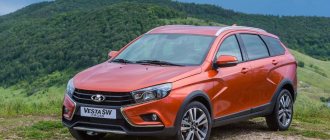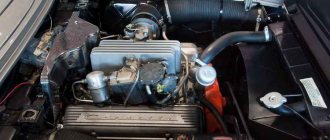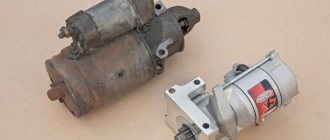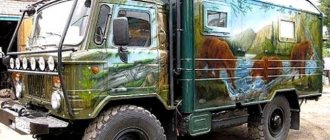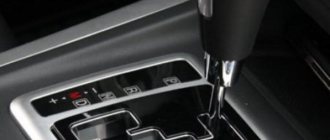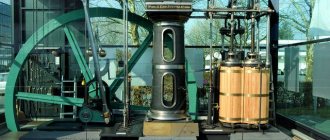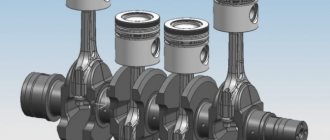What is an SUV
The concept of “SUV” is broad, because it covers the entire range of vehicles characterized by increased cross-country ability. This car is designed for off-road travel and special routes.
The main differences between 4x4 vehicles are the frame design, low gear range, inter-wheel and inter-axle locks, durable suspension, and so on.
The SUV is capable of overcoming obstacles, towing other vehicles, and traveling off-road.
The main disadvantage is that combining the above-mentioned qualities with efficiency is impossible.
In addition, even the use of new technologies does not guarantee handling on the highway (comparable to passenger cars).
Despite the apparent spaciousness in the cabin, there is no need to talk about comfort. These cars are workhorses designed for off-road travel.
The main representatives of the SUV class are the Grand Cherokee, UAZ series cars (Russia), Jeep, Nissan Patrol and others.
About wheels and maneuverability
The most fundamental differences between SUVs, SUVs and crossovers are expressed in the features of their wheels and geometric cross-country ability.
The SUV is equipped with large wheels (thirty inches in diameter and above) with high sidewalls. And crossovers and SUVs can have conventional low-profile ones designed for driving traffic on asphalt.
SUV wheels must be of large diameter (from 30 inches) with a high sidewall. While crossovers and SUVs can be equipped with low-profile tires for driving on asphalt. The cross-country ability of SUVs has been significantly increased by reducing the overhangs of the stern and front of the car. This allows you to increase departure and approach angles during sharp or unexpected descents and ascents. The cross-country ability of crossovers and SUVs is lower, as they are equipped with fairly large overhangs. The reason for this is that in the design of cars such as an SUV or crossover, the main indicator is the aesthetic aspect, and not the physical one.
When mentioning geometric cross-country ability, it is important to note that its main definition is the ability to overcome obstacles of varying complexity.
What is a crossover
A crossover is a car that successfully combines a passenger car and an SUV. The main difference is the increased level of comfort.
The advantages of crossovers are cross-country ability, which is higher than that of passenger cars, sporty appearance, all-wheel drive (not always).
Crossovers are equipped with powerful engines and are easy to handle at speed.
Unlike an SUV, a crossover copes with serious off-road conditions less quickly. Such cars are designed for travel on asphalt roads, although the car feels confident on the ground.
The main design differences are ground clearance, two-volume body, all-wheel drive, and sophisticated steering.
In addition, crossovers have a built-in frame, which is reinforced with special side members (the body becomes stiffer).
Some crossovers are equipped with a full “off-road package” - a locking drive and electronic systems that provide cross-country ability on “average” off-road conditions.
In addition, such vehicles cope without problems on roads where there are no obstacles to the power unit and other mechanisms under the bottom of the vehicle.
Among the popular crossovers it is worth highlighting - Porsche Cayenne, Lexus RX, Mercedes-Benz M-Class, Saab 9-4X, Mitsubishi Outlander, Hyundai Santa Fe and others.
Subaru Crosstrek 2019
The 2021 Subaru Crosstrek all-wheel drive SUV offers a wide range of features at a reasonable price of $22,900-$36,000.
Subaru Crosstrek 2019
If we're just talking about everyday tasks, the 2021 Crosstrek is a perfectly acceptable reliable companion. Comfortable but manageable, quite quiet and calm. The biggest drawback, which also affected the previous generation, is that the engine power (152 horsepower) is barely sufficient, especially when venturing out onto the highway or overtaking. The standard transmission is a 6-speed manual, which doesn't really help get the most out of the engine. An automatic alternative is a continuously variable transmission (CVT), which is known for being slow to respond. At least the new Crosstrek has 22cm of usable ground clearance.
Although the new Crosstrek Hybrid is heavier and less powerful than the non-hybrid, it is actually slightly faster, although both boast only moderate, albeit adequate, power. The hybrid is also quieter thanks to additional sound insulation. And when the going gets tough, the Subaru Hybrid's all-wheel drive and off-road instincts come to the fore, and the standard X-Mode with Hill Descent Control masterfully tames slippery downhill descents.
Peculiarities:
- X-Mode Hill Descent Control function.
If the Crosstrek driver is adventurous enough to take on a steep, slippery downhill grade, this feature will come in handy. Just press the appropriate button and concentrate solely on steering without having to control the speed of the car. The Crosstrek's X-Mode system (CVT models only) handles the rest. The function is especially useful for Russia with our roads.
- Apple Carplay and Android Auto.
We recommend: The best cars from China on the Russian market in 2019
Smartphone integration is becoming increasingly popular in new cars. Even the lowest trim level of the 2021 Crosstrek comes standard with the feature.
Interior and exterior
The 5-passenger Crosstrek has a decent amount of cargo and passenger space for an SUV. The rear seats fold down, opening up between 580 and 1,560 liters of space. The A-pillars and side pillars are relatively thin, contributing to the premium appearance, and the dashboard is unfussy and contains good quality materials. Most users' complaints center around the hard front headrests and the fact that the Crosstrek Hybrid's battery compromises rear trunk capacity. The seats could use a little more lower back support.
Each driver has his own idea of a good appearance of a car, but Subaru has never been a company that would pay much attention to external design. Plus, the current Crosstrek isn't all that different from its predecessor. This is hardly a problem, since this car has other advantages and sells quite well.
Subaru fans will appreciate the fact that the new Crosstrek's tailgate is 4 inches wider than the first generation, creating a larger compartment through which to load luggage and sports equipment. Roof rails are also standard equipment. The Crosstrek Hybrid has its own exterior color scheme and a gloss black rear roof spoiler.
Standard and optional equipment
The 2021 Crosstrek lineup starts with 17-inch alloy wheels, a rearview camera, Bluetooth, audio, smartphone integration, all-wheel drive with torque vectoring, an optional airbag and a 6.5-inch touchscreen. For an additional $1,000, the Premium trim adds a leather-wrapped steering wheel, a sound-insulated windshield, heated front seats and side mirrors, fog lights, and an upgraded infotainment system that includes satellite radio and Subaru's Starlink assist system (with emergency system), remote lock/unlock, stolen vehicle recovery service and automatic collision notification. Optional equipment includes 18-inch alloy wheels, leather upholstery, an 8-inch touchscreen and some advanced driver aids.
Standard goodies on the generously equipped Crosstrek Hybrid include leather upholstery in exclusive colors, a power driver's seat, heated front seats, keyless entry and push-button start, 18-inch wheels, as well as the EyeSight suite of safety features, blind-spot detection and rear cross-traffic alert. with automatic braking.
The base 2.0i can be equipped with adaptive cruise control, lane keeping assist and front crash mitigation. The Premium trim may also include blind-spot monitoring with rear cross-traffic alert. Other options include a power sunroof, navigation, reverse automatic braking and a Harman Kardon audio system. The Crosstrek Hybrid's only option is a $2,500 package that includes a sunroof, navigation and Harman Kardon audio, and a heated steering wheel.
What is a SUV
An SUV or “sports car” is a term that characterizes the “flattered” version of SUVs.
The main difference between such cars is their inability to overcome difficult obstacles (unlike their SUV “brothers”).
In terms of characteristics, SUVs are closer to passenger cars, but thanks to their versatility, they are capable of performing a number of other tasks. These include transporting large cargo or passengers (6 people or more), traveling on light off-road conditions or towing trailers.
SUVs are equipped with a monocoque body (unlike SUVs, which have a rigid frame).
The advantages of such cars are a high ceiling, a comfortable seating position, a spacious interior, and decent cross-country ability (for dirt roads).
In recent years, SUV manufacturers have switched from the issue of cross-country ability and are paying more attention to fuel consumption, as well as reducing air resistance.
Of the design features of SUVs, it is worth highlighting - increased ground clearance (when compared with passenger cars), handling, comfort, price (lower than SUVs and crossovers).
The first SUVs in the West were Dodge and Land Rover. In the USSR - GAZ-M-72, Moskvich-410 and others.
Over time, such transport became popular in dozens of countries around the world. Among modern SUVs, it is worth highlighting the Hyundai ix35, Toyota RAV4 and others.
Main representatives of classes
SUVs were the first to appear among the representatives of the classes under consideration. Now the proportions of sales of SUVs, SUVs and crossovers are almost equal. At the same time, the share of SUVs sold is gradually falling, while crossovers and SUVs are growing.
SUVs
The first mass-produced SUV was the legendary Willys MB, which appeared during the Second World War. Gradually, SUVs won the hearts of ordinary buyers due to their unpretentiousness and ease of use in rural areas. Nowadays, the class of SUVs includes such domestic cars as the UAZ models (Patriot and Hunter) and the legendary classic Niva. Among the foreign models, one cannot fail to note the Japanese frame ones, especially the models of the Toyota concern - Land Cruiser 200, Land Cruiser Prado and 4Runner. Other manufacturers from the Land of the Rising Sun also produce full-fledged SUVs. These include the Mitsubishi Pajero Sport, Nissan Patrol and the peculiar Suzuki Jimny. Many SUVs are found among models of premium Japanese brands: Infiniti QX80, Lexus LX and GX compete with premium American SUVs Chevrolet Tahoe, Cadillac Escalade and Jeep Grand Cherokee. Among the European automotive giants there are practically no SUVs, but it is worth noting the legendary models - Land Rover Defender and Mercedes-Benz G-Class.
The most recognizable SUVs include the Toyota Land Cruiser, Mitsubishi Pajero, Suzuki Jimny and Jeep Grand Cherokee.
Crossovers
Toyota RAV4 is one of the first full-fledged crossovers, and is now considered the leader in this segment. Over time, crossovers won the hearts of buyers, so that now a rare manufacturer can do without a car of this class in its lineup. Crossovers include such models from Japanese concerns as:
- Toyota Highlander;
- Nissan X-Trail, Murano, Rogue and Pathfinder;
- Subaru Forester;
- Honda CRV and Pilot;
- Mitsubishi Outlander;
- Suzuki Grand Vitara.
Manufacturers from other countries are not lagging behind the Japanese. Among the Korean crossovers, one cannot fail to mention the Hyundai Tucson, Hyundai Santa Fe, Kia Sportage and Kia Sorento. Almost all off-road vehicles among European concerns are also crossovers. These are, for example, representatives of the German brand Volkswagen (Tiguan and Touareg), although regarding the “Tuareg” there continues to be debate about what type of car it should be classified as. Many models of premium brands are considered crossovers: Volvo XC 90, BMW X1, X3 and X5, Mercedes GLK and others. Among the crossovers is one of the leaders in the Russian market, Renault Duster, which has an all-wheel drive system in almost all trim levels.
Some of the most striking crossovers are the Toyota Highlander, Honda CRV, Kia Sportage and Volvo XC90
SUVs
SUVs for the most part are B and C class models “made up” to look like crossovers and have increased ground clearance. A special feature of SUVs is that they are often produced on the basis of existing models. Thanks to the unification of parts, their production is much cheaper. Often they are just slightly raised hatchbacks or station wagons, but sometimes engineers develop a separate body for them. Representatives of this class include Nissan Qashqai and Juke, Kia Soul, Renault Sandero Stepway, Hyundai Creta, although the latter is at the intersection of classes and may well qualify as a crossover. An example of a domestic SUV is the AvtoVAZ Lada XRAY model.
Cars such as Nissan Qashqai, Kia Soul, Lada XRAY and Peugeot 3008 are skillfully disguised as crossovers, although in fact they are SUVs
What are the differences
As is clear from the description above, SUVs, crossovers and SUVs have a number of differences:
1. Body part:
Crossovers.
As a rule, they differ in frame construction, but recently they are increasingly produced on load-bearing bodies.
Advantages: low weight (compared to frame options), ease of maintenance, minimal restoration costs.
The clearance of crossovers is 20-25 centimeters, which is enough to overcome even high obstacles. In some models, the ground clearance is lower, which affects the vehicle's maneuverability;
SUVs.
Cars that have a station wagon body type (rarely a hatchback).
The main difference between the bodies is that they are load-bearing, but their structure is almost no different from those mounted on passenger cars.
The ground clearance (compared to a passenger car) is 3-5 centimeters higher, which does not guarantee the vehicle’s all-terrain capability. Plus - ease of maneuvering and comfort.
There are no problems avoiding open sewer manholes, curbs and other obstacles on the road.
To make them look like SUVs, SUVs are equipped with various “trinkets” that are typical only for “Jeeps”.
Unlike SUVs, the interior of SUVs is made to be of the “luxury” class;
SUV.
A car with a rigid frame installed that can withstand powerful loads.
Although, in recent years, manufacturers have been saving on frames and achieving reliability through auxiliary elements.
Thus, SUVs are conventionally divided into two categories - those equipped with a monocoque body and frame ones.
The former are special in that the body takes on the main function, while the latter have a rigid frame.
Over the last 3-5 years, another type of body has been gaining popularity - an integrated frame, which is something in common with the designs mentioned above.
2. Chassis:
Crossovers.
They are equipped with a chassis that differs in design from the chassis of an SUV, but is also somewhat similar to it.
Common features - increased stroke, design simplicity, ease of use. The front suspension is made using independent structures, and the rear suspension is in the form of a dependent axle.
SUVs.
Cars that are similar in chassis design to crossovers, but similar to passenger cars.
The main difference is the presence of reinforced chassis components and the use of a number of technical solutions that allow off-road driving.
SUVs are often equipped with an adaptive suspension with the function of changing the ground clearance and adjusting the stiffness of the shock absorber.
SUV tires have a high profile (sometimes low-profile tires are installed), which are not suitable for traction on unpaved roads.
Such cars are suitable for traveling on flat and asphalt roads, but they will not get lost when driving onto a dirt road.
SUVs (we are talking about the chassis).
Vehicles equipped with fully or partially dependent suspension.
You should not expect comfort with such a design, but reliability is guaranteed.
In addition, the SUV's chassis is distinguished by its safety margin, which opens the way for overcoming the most serious obstacles.
SUVs have more suspension travel, which ensures that the wheel stays on the ground even when driving off-road.
3. Transmission:
Crossovers.
Manufacturers are 100% successful with the latest models. Competent developers were able to use the capabilities of the 4x4 drive, which is connected only when necessary.
As for the distribution of torque, this process is controlled electronically. The latter's task is to report the presence of slippage.
Thus, the Honda company uses hydraulic locking, which transmits rotation to the towing axle through a special coupling;
SUVs.
On such machines all-wheel drive is installed, but there is no low gear.
The car drives on front wheel drive, and the rear wheel drive is engaged only when the front wheels slip. At the same time, the main drawback is that the rear axle is connected late, due to which the machine “buries” in the ground even before the auxiliary device is turned on.
In addition, the SUV should not be used off-road due to the risk of viscous coupling overheating during long-term towing. In this case, the driver will have to wait until the device cools down.
SUV.
The jeep is equipped with a permanent 4x4 drive. An alternative is the ability to connect a second drive if necessary.
In such cases, the bridge is switched on manually, and not using a viscous coupling.
In addition, on SUVs it is mandatory to install a center differential with mechanical or cross-axle locking.
If a car does not have a downshift, then it is no longer an SUV, but a crossover.
4. Engine:
SUVs and crossovers.
Cars that typically travel on paved roads and in urban environments.
This means that the power units differ slightly from the engines installed in passenger cars.
Preference is given to gasoline units, but diesel engines are not rejected.
SUV.
Unlike SUVs and crossovers, an SUV has to overcome obstacles at low speed. This means that it is impossible to do without appropriate traction and reserve torque.
The engine of an SUV should not so much accelerate the car as pull it through even in the most difficult conditions. If we are talking about a gasoline engine, then the volume should be 2 liters or more.
Powerful motors have a number of advantages - traction at low speeds, elasticity, the ability to distribute power throughout the entire operating range, and reliability.
The considered qualities guarantee effective traction control when driving off-road.
Such engines have one drawback - excessive “gluttony”, which not all car enthusiasts can cope with.
For this reason, SUVs are increasingly equipped with a diesel engine, the efficiency of which does not prevent it from delivering sufficient power with incredible torque.
In addition, diesel fuel is available off-road, but AI-95 is not always available.
World market leaders in the production of crossovers, SUVs and SUVs
Car manufacturers know how to delight with new and advanced models.
But among SUVs, crossovers and SUVs, it is worth highlighting a number of leaders who hold the “palm”:
- SUVs. In the SUV section, it is worth highlighting such manufacturers as Toyota and its Toyota RAV4 or Toyota FJ Cruiser, the famous Japanese brand Honda and its Honda CR-V, the Suzuki company and its famous Suzuki Grand Vitara;
- Crossovers. The German concern BMW has become famous in this area with its X5, X6 and X1, Mercedes-Benz and GLK, Infinity FX50 or EX, Audi Q5 and Q7. We can't forget about the Porsche Cayenne;
- SUVs. Among the SUVs, it is worth highlighting the Russian VAZ and its Niva, the UAZ, Mercedes-Benz models and the ML/G series cars.
Technical features
Now you should understand the specific technical features of each of these classes of cars, which determine their main differences from each other.
Patency
The main differences between all three classes of cars lie in cross-country ability, the difference of which is determined by the design of the vehicle components. SUVs are characterized by increased cross-country ability - they can overcome rough terrain quite easily.
The element of SUVs and crossovers is asphalt roads. However, if an SUV can get stuck even on a road that has not been cleared of snow, then the crossover can handle rural roads, and sometimes even light off-road conditions. The SUV is a purely city car, and in terms of cross-country ability it is not much different from golf-class cars.
Wheels
SUVs and crossovers are usually equipped with standard low-profile tires. The wheel size is normal, like for cars. As for SUVs, due to the large size of such vehicles and the need to travel off-road, large wheels are installed on them - from 30 inches.
Driving an SUV means increased load on the wheels, so the tires must be of the appropriate size.
Body
Until recently, a frame body structure was strictly mandatory for real SUVs. The frame chassis, on which the rest of the vehicle’s components and assemblies are mounted, allows the SUV to evenly distribute the load, which is an advantage on rough terrain. This design allows you to raise the car body to install wheels of larger diameter, which also leads to increased cross-country ability. The body is attached to the frame using brackets. It can be semi-load-bearing (partially bears the load on the frame) or completely unloaded (found only on commercial vehicles).
The disadvantage of the frame structure is the vibrations transmitted to the body at high speeds, which reduces the comfort of travel on frame SUVs. To reduce vibrations, it is necessary to increase the mass of the body, which leads either to a decrease in speed characteristics, or, with an increase in engine power, to an increase in fuel consumption. Therefore, even full-fledged SUVs are gradually moving away from a rigid frame structure and often use a lightweight frame with a semi-supporting body.
As for SUVs and crossovers, they do not use a frame structure. The load is borne by a fully load-bearing body. This design makes it possible to lighten the weight of the car, but such a body is not suitable for off-road use - due to the uneven distribution of load on an uneven surface, a load-bearing body is less preferable. It is worth noting that some crossover models use an integrated design with subframes or side members that are integrated into the power frame of the body. This design increases body rigidity, which has a positive effect on vehicle handling.
Frame design involves attaching the body, suspension and engine to a frame consisting of channels
Transmission
On SUVs, the transmission looks rather banal - a regular manual or automatic transmission without any frills. The car's drive is in most cases front-wheel drive.
With SUVs things are much more interesting. It is the transmission of these cars that largely determines the increased cross-country ability of representatives of this class.
On full-fledged SUVs, a transfer case is used, which allows the torque to be distributed between the axles and increased on the drive wheels. The transfer case is equipped with a reduction gear, which serves to increase torque when driving off-road. It is also equipped with a center differential to distribute torque between the axles. If the car is equipped with a center differential lock, then this allows you to solve the problem of a hanging wheel when only one wheel rotates. Locking the center differential allows all four wheels to rotate synchronously, including the suspended one. It can be automatic or forcibly connected at the driver’s request. All-wheel drive can be permanent or off-road.
As for crossovers, in terms of transmission they are close to SUVs, although many models have all-wheel drive. On modern crossovers it is most often electronic - the control unit detects slippage and connects the second axle. There is no transfer case or downshift on crossovers - these functions are simply not needed on asphalt. In inexpensive trim levels, crossovers are not equipped with all-wheel drive - only one axle is driven.
Suspension
Finally, let's look at the last node, which reveals the difference between the presented types of cars. Crossovers are usually equipped with an independent multi-link suspension, which is so necessary to improve handling on smooth asphalt roads. The suspension of SUVs is a little simpler - often the rear axle is a torsion beam, and only the front axle is independent.
In the modern world, multi-link independent suspension is the most common type of suspension and is often used on crossovers
As for full-fledged SUVs, their suspension is usually dependent with a continuous axle. This type of suspension for off-road vehicles comes in two varieties: with longitudinal springs and with guide arms. SUVs are characterized by long suspension travel, which is invaluable in rough terrain. In general, the suspension of SUVs is highly reliable, but it is not very comfortable when driving at high speeds on asphalt. The handling of SUVs can be described as average.
